Biodegradable Mulch Film Market Size
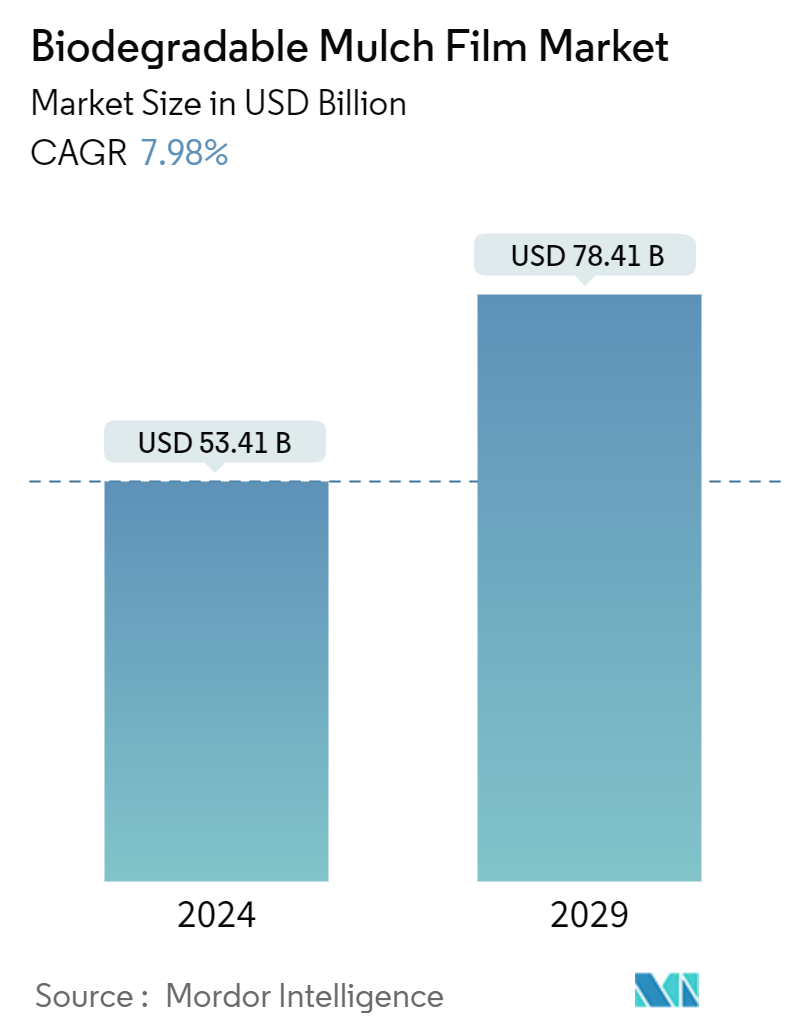
| Study Period | 2019 - 2029 |
| Market Size (2024) | USD 53.41 Billion |
| Market Size (2029) | USD 78.41 Billion |
| CAGR (2024 - 2029) | 7.98 % |
| Fastest Growing Market | Asia Pacific |
| Largest Market | North America |
Major Players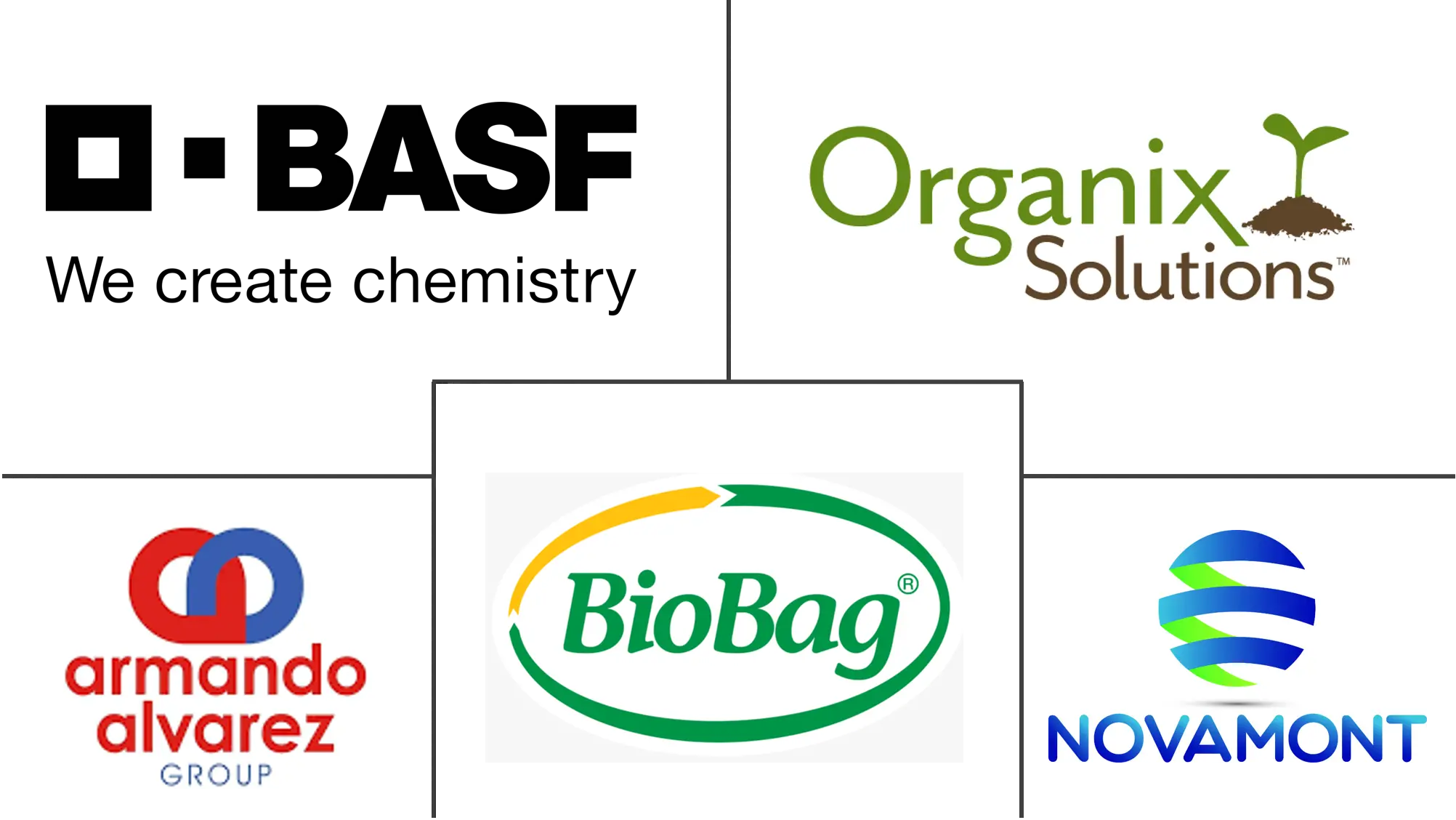
*Disclaimer: Major Players sorted in no particular order |
Biodegradable Mulch Film Market Analysis
The Biodegradable Mulch Film Market size is estimated at USD 53.41 billion in 2024, and is expected to reach USD 78.41 billion by 2029, growing at a CAGR of 7.98% during the forecast period (2024-2029).
- Biodegradability in the soil provides huge benefits for agricultural and horticultural products. Biodegradable mulching films have made rapid improvements in terms of usability, allowing cultivators to plow in bioplastic mulch after use instead of collecting them from the field for recycling, which improves operational efficiency. However, the potential environmental consequences of using biodegradable mulches have not been thoroughly studied, and international standards, such as ISO 17088, ASTM D6400, ISO 17556, and ASTM D5988, for validating their safeness are in the ongoing research phase.
- Non-biodegradable mulch films, when not properly disposed of, can lead to the loss of agricultural topsoil, with an estimated 166 kiloton/year dragged away from fields at the end of each crop cycle. In contrast, certified soil-biodegradable mulch films, with their biodegradability, not only prevent this soil loss but also play a crucial role in halting the leakage and accumulation of microplastics in agricultural soils. Additionally, these certified mulch films help curb the production of plastic waste that is notoriously challenging to recycle.
- The expansion of the greenhouse project drives the market. According to the World Greenhouse Vegetable Statistics, there are 1,228,000 acres of greenhouse growing space for production worldwide. Biodegradable plastic mulch fragments physically modify soil before they are fully biodegraded. However, PE plastic fragments reduce soil infiltration and water absorption, by which the accumulation may affect soil ecosystems in greenhouse plantations and, ultimately, result in plant germination and growth. Thus, the demand for biodegradable mulch film market increases in this segment.
- Supportive regulation from the governments for organic mulching across the world is driving the market. For instance, in Europe, EN 17033 is the new product standard made for biodegradable mulch films used in agriculture and horticulture and specifies the necessary requirements and test methods. The standard is designed for a clear reference to farmers, distributors, and stakeholders. EN 17033 is more likely to replace other pre-existing national standards in Europe.
- High installation cost, along with the addition of harmful additives during the manufacturing process, challenges the growth of the market. The deficit in the availability of such mulch films with high initial costs is challenging the growth. Moreover, the involvement of plasticizers in the manufacturing of biodegradable mulch film to make profits may challenge the market with growing awareness among the farmers.
Biodegradable Mulch Film Market Trends
Fruits and Vegetables to Account for a Significant Share
- Mulch films, whether black or transparent, play a crucial role in modern agriculture. They facilitate the planting or direct sowing of crops through punched holes, enhancing several factors pivotal for crop growth. This method not only boosts the effectiveness of growing various vegetables but also leads to earlier harvests, increased yields, and improved produce quality.
- Moreover, these films significantly reduce moisture loss from the soil, keeping the ground moist and subsequently cutting down on the need for additional watering, thus reducing costs. Field trials have demonstrated that using agricultural films can nearly double vegetable harvests compared to traditional methods.
- Black and black/white mulch films serve a dual purpose. They not only prevent weed growth but also shield against accompanying flora. Additionally, these films act as a protective barrier against rain, safeguarding valuable agrochemicals and fertilizers from being washed away. By maintaining soil moisture, they also prevent soil compaction, ensuring it stays loose and conducive for plant growth.
- Due to the large proportion of mulch films used in fruits and vegetables and all the environmental problems related to their disposal, biodegradable mulch films seem to be the best solution for replacing conventional polyethylene mulches.
- Additionally, traditional mulch film waste causes an environmental problem because it is very contaminated with soil and vegetable residues, making the recycling process expensive, time-consuming, and an uneconomic activity. These biodegradable mulch films have the advantage of being disposed directly into the soil or into a composting system at the end of their lifetime and undergo biodegradation by soil microorganisms. This saves time and money.
- BASF offers the polymer Ecovio M, which is made up of polymer PLA (polylactic acid), which has biobased content and is completely biodegradable. Its advantage is that the farmer does not have to laboriously collect the mulch films after harvest but can plow them directly, which helps save time and money.
- Furthermore, Italy exports tons of fresh fruits and vegetables to other countries annually, and players such as Novamont offer Mater-Bi mulch film for processing vegetables. Italy is the main European producer of tomatoes. According to the Associazione Nazionale Industriali Conserve Alimentari Vegetali, the export value of tomato products in Italy rose by 25.2% in 2023 compared to the previous year.
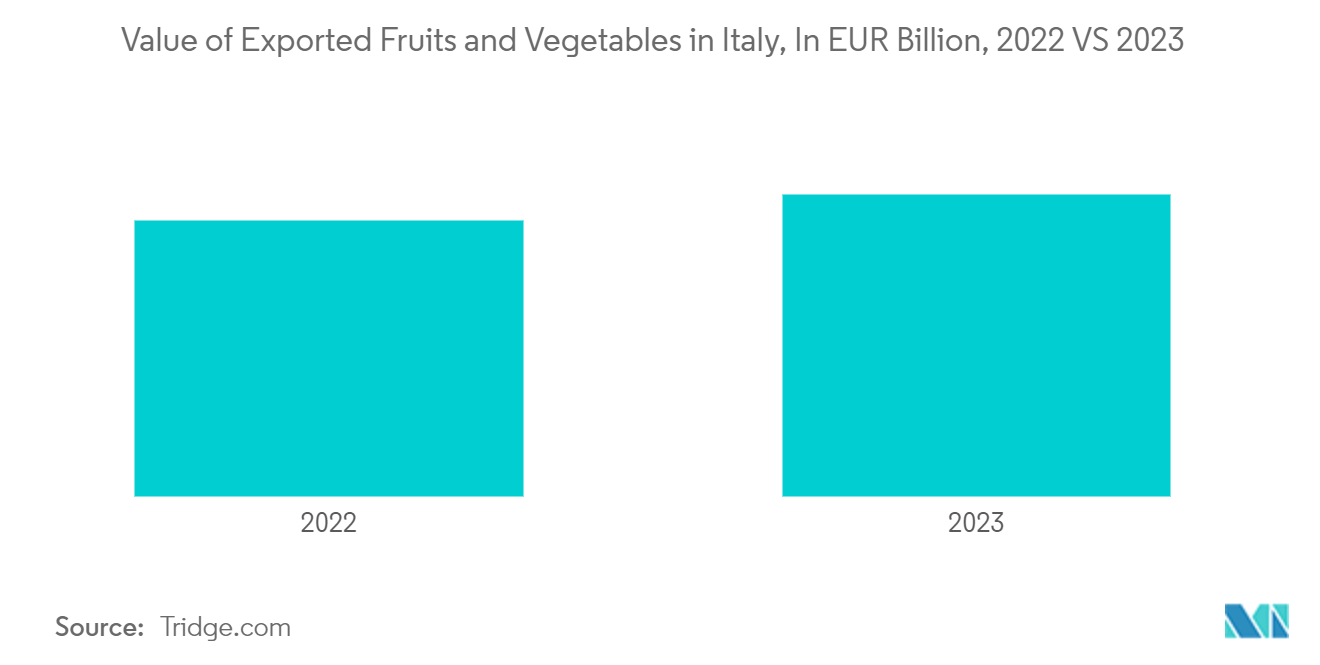
Asia-Pacific to Witness Significant Market Growth
- Asia-Pacific is projected to register the highest rate in biodegradable mulch film, as the increasing population, especially in China and India, is increasing the demand for food, increasing the usage of biodegradable mulch films in crop production.
- The government is also taking necessary steps to improve the productivity of crops. In China, the government’s National Development and Reform Commission stated that China wants to promote non-plastic products, including biodegradable mulch film, in the agriculture sector.
- Additionally, in India, the government estimates an increase in pulse production for the coming years, which is expected to significantly raise the demand for biodegradable mulch films. According to PIB, 273.02 lakh tonnes of pulses were expected to be farmed during 2021-2022, with an increment of 275.04 lakh tonnes compared to 2022-2023.
- Furthermore, in May 2023, Singapore's RWDC Industries, a biotech start-up pioneering biopolymer solutions as alternatives to petroleum-based plastics, and Lummus Technology, a provider in process technology, inked a memorandum of understanding (MOU). This collaboration aims to spearhead worldwide initiatives for deploying PHA, a biodegradable polymer.
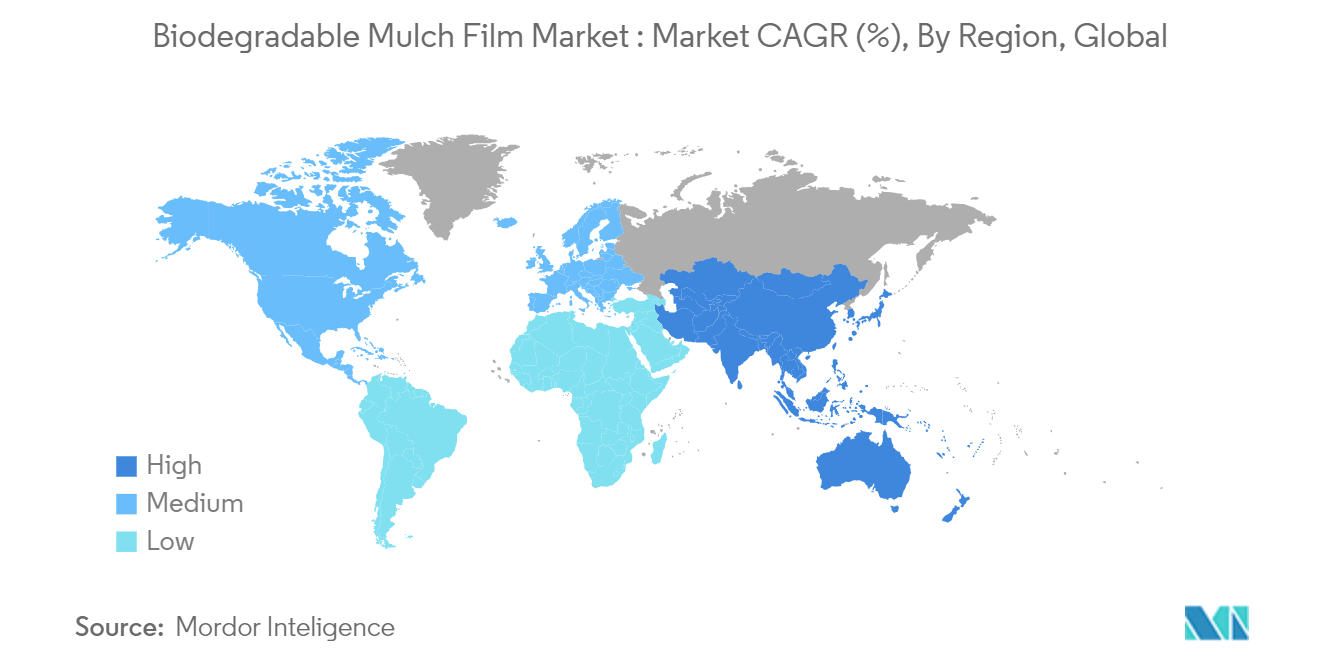
Biodegradable Mulch Film Industry Overview
The biodegradable mulch film market is fragmented, and the major players are using various strategies, such as new product launches and agreements, to increase their footprints in this market. Key players in the market are BASF SE, BioBag International AS, etc.
- October 2023: Packaging and paper provider Mondi teamed up with Cotesi, a prominent producer of twine, nets, and ropes for agriculture, in a joint effort to bolster sustainability in the agricultural sector. Their collaboration centers around the launch of a new paper-based solution, Advantage Kraft Mulch. This innovative product is designed to supplant the conventional plastic mulch films that have long been a staple for farmers. Mulch films play a crucial role in agriculture, shielding crops from a gamut of threats, including birds, weeds, soil erosion, excessive sunlight, and heavy rain. Traditionally, these films were crafted from plastic, laid out during planting, and subsequently discarded at harvest, exacerbating the prevalent plastic waste dilemma.
Biodegradable Mulch Film Market Leaders
-
BASF SE
-
BioBag International AS
-
Organix A.G
-
Armando Alvarez Group
-
Novamont S.p.A.
*Disclaimer: Major Players sorted in no particular order
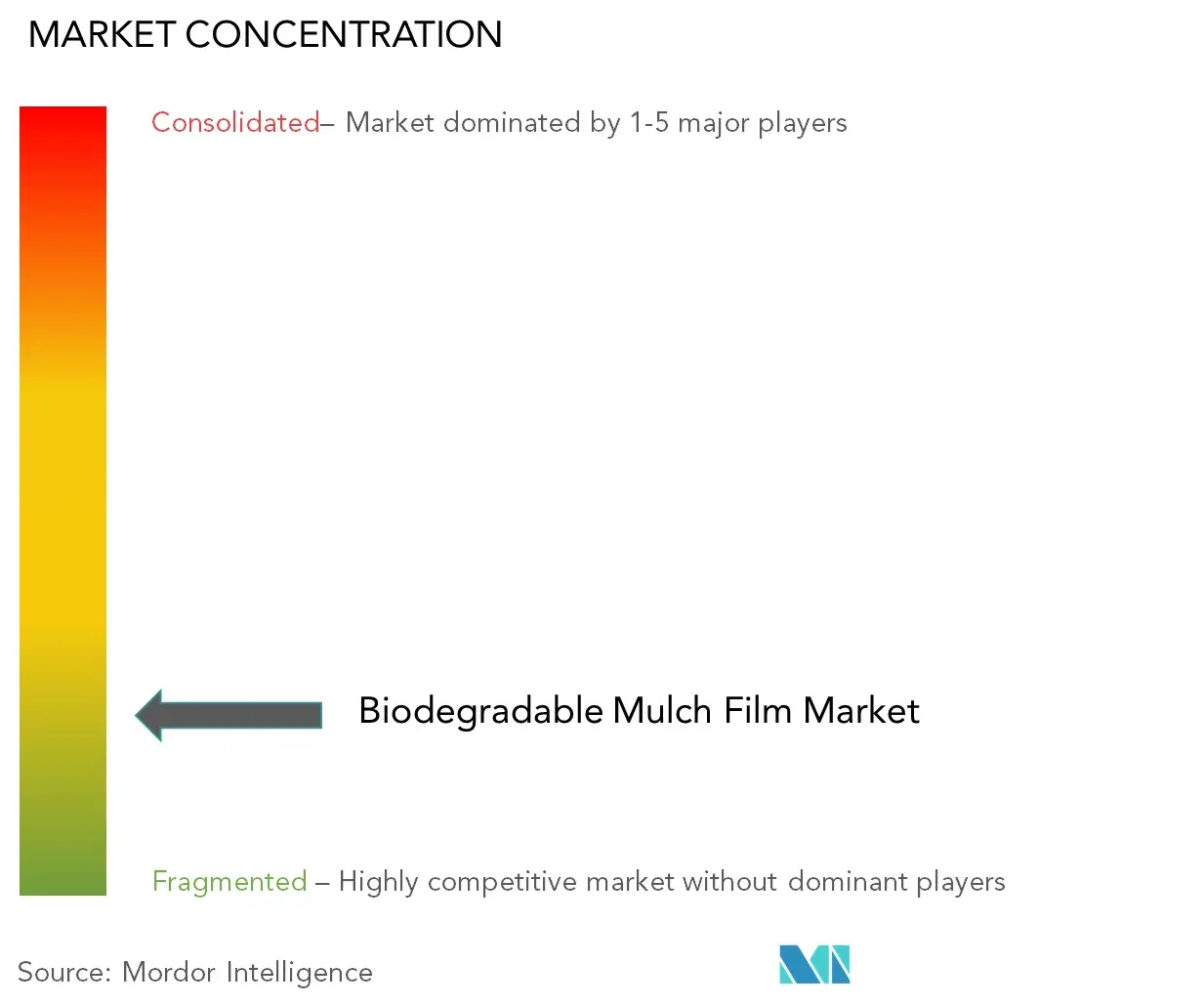
Biodegradable Mulch Film Market News
- June 2024: NUREL launched two novel INZEA biopolymer variants tailored for crafting agricultural mulch films. Agricultural mulch films play a pivotal role: they aid in weed control, cut down on irrigation water usage, mitigate soil erosion, and elevate soil temperatures, ultimately enhancing early yields. These latest INZEA offerings from NUREL not only streamline plastic waste handling but also combat the formation of microplastics, underscoring a shift towards greener agricultural practices.
Biodegradable Mulch Film Market Report - Table of Contents
1. INTRODUCTION
- 1.1 Study Deliverables
- 1.2 Study Assumptions
- 1.3 Scope of the Study
2. RESEARCH METHODOLOGY
3. EXECUTIVE SUMMARY
4. MARKET DYNAMICS
- 4.1 Market Overview
-
4.2 Market Drivers
- 4.2.1 Expansion of Greenhouse Projects
- 4.2.2 Supportive Regulation from the Governments for Organic Mulching Across the World
-
4.3 Market Restraints
- 4.3.1 High Installation Cost and Addition of Harmful Additives in Manufacturing
- 4.4 Industry Value Chain Analysis
-
4.5 Industry Attractiveness - Porter's Five Forces Analysis
- 4.5.1 Threat of New Entrants
- 4.5.2 Bargaining Power of Buyers/Consumers
- 4.5.3 Bargaining Power of Suppliers
- 4.5.4 Threat of Substitute Products
- 4.5.5 Intensity of Competitive Rivalry
5. MARKET SEGMENTATION
-
5.1 By Polymer
- 5.1.1 Starch
- 5.1.2 Polyhydroxyalkanoates (PHA)
- 5.1.3 Polylactic Acid (PLA)
- 5.1.4 Other Polymers (Aliphatic-Aromatic Copolymers (AAC))
-
5.2 By Application
- 5.2.1 Fruits and Vegetables
- 5.2.2 Flowers and Plants
- 5.2.3 Grains and Oilseeds
-
5.3 By Geography
- 5.3.1 North America
- 5.3.1.1 United States
- 5.3.1.2 Canada
- 5.3.2 Europe
- 5.3.2.1 Germany
- 5.3.2.2 United Kingdom
- 5.3.2.3 France
- 5.3.2.4 Italy
- 5.3.2.5 Rest of Europe
- 5.3.3 Asia-Pacific
- 5.3.3.1 India
- 5.3.3.2 China
- 5.3.3.3 Japan
- 5.3.3.4 Rest of Asia-Pacific
- 5.3.4 Rest of the World
6. COMPETITIVE LANDSCAPE
-
6.1 Company Profiles
- 6.1.1 BASF SE
- 6.1.2 BioBag International AS
- 6.1.3 Organix AG
- 6.1.4 Armando Alvarez Group
- 6.1.5 Novamont SpA
- 6.1.6 Agriplast Tech India Pvt. Ltd
- 6.1.7 Pooja Plastic Industries
- 6.1.8 Barbier Group
- 6.1.9 Dubois Agrinovation
- 6.1.10 Hopewell Industries
- *List Not Exhaustive
- 6.2 Investment Analysis
7. MARKET OPPORTUNITIES AND FUTURE TRENDS
** Subject To AvailablityBiodegradable Mulch Film Industry Segmentation
Biodegradable mulch films are organic mulching materials offering benefits such as weed control, maintenance of soil structure, and prevention of crops from soil contamination.
The study tracks the demand for biodegradable mulch film based on their applications in key end-user verticals. The market size and demand are represented in terms of revenue (USD). The scope of the study focuses on analyzing the revenue accrued from biodegradable Mulch Film vendors operating in the global market. The analysis is based on the market insights captured through secondary research and the primaries.
The biodegradable mulch film market is segmented by polymer (starch, polyhydroxyalkanoates [PHA], polyactic acid [PLA], and other polymers), application (fruits and vegetables, flowers and plants, and grains and oilseeds), and geography. The report offers market forecasts and size in value (USD) for all the above segments.
| By Polymer | Starch | |
| Polyhydroxyalkanoates (PHA) | ||
| Polylactic Acid (PLA) | ||
| Other Polymers (Aliphatic-Aromatic Copolymers (AAC)) | ||
| By Application | Fruits and Vegetables | |
| Flowers and Plants | ||
| Grains and Oilseeds | ||
| By Geography | North America | United States |
| Canada | ||
| By Geography | Europe | Germany |
| United Kingdom | ||
| France | ||
| Italy | ||
| Rest of Europe | ||
| By Geography | Asia-Pacific | India |
| China | ||
| Japan | ||
| Rest of Asia-Pacific | ||
| By Geography | Rest of the World |
Biodegradable Mulch Film Market Research FAQs
How big is the Biodegradable Mulch Film Market?
The Biodegradable Mulch Film Market size is expected to reach USD 53.41 billion in 2024 and grow at a CAGR of 7.98% to reach USD 78.41 billion by 2029.
What is the current Biodegradable Mulch Film Market size?
In 2024, the Biodegradable Mulch Film Market size is expected to reach USD 53.41 billion.
Who are the key players in Biodegradable Mulch Film Market?
BASF SE, BioBag International AS, Organix A.G, Armando Alvarez Group and Novamont S.p.A. are the major companies operating in the Biodegradable Mulch Film Market.
Which is the fastest growing region in Biodegradable Mulch Film Market?
Asia Pacific is estimated to grow at the highest CAGR over the forecast period (2024-2029).
Which region has the biggest share in Biodegradable Mulch Film Market?
In 2024, the North America accounts for the largest market share in Biodegradable Mulch Film Market.
What years does this Biodegradable Mulch Film Market cover, and what was the market size in 2023?
In 2023, the Biodegradable Mulch Film Market size was estimated at USD 49.15 billion. The report covers the Biodegradable Mulch Film Market historical market size for years: 2019, 2020, 2021, 2022 and 2023. The report also forecasts the Biodegradable Mulch Film Market size for years: 2024, 2025, 2026, 2027, 2028 and 2029.
Biodegradable Mulch Film Industry Report
The report on the Global Biodegradable Mulch Film Market provides a comprehensive industry overview, highlighting the market size and trends. It is segmented by polymer types, including starch, polyhydroxyalkanoates (PHA), and polylactic acid (PLA), as well as by application areas such as fruits and vegetables, flowers and plants, and grains and oilseeds. The report offers a detailed market analysis, including market segmentation and market forecast, giving insights into the market growth and market value.
Industry reports from Mordor Intelligence™ provide a historical overview and a market forecast outlook, offering industry statistics and industry information essential for understanding market dynamics. The market review includes market data and market predictions, identifying key market leaders and their influence on market trends. This industry research is crucial for companies looking to understand industry size and industry sales.
The report also includes a sample of the industry analysis available as a free report PDF download, offering a glimpse into the comprehensive market research conducted. The report example provided helps illustrate the depth of market segmentation and market outlook, ensuring that stakeholders have access to valuable industry insights.
Overall, the report is an essential tool for research companies and industry professionals seeking to understand the growth rate and market dynamics of the biodegradable mulch film market. The detailed market overview and market forecast provide a clear picture of the market's future, making it easier for companies to strategize and plan their market approach.



